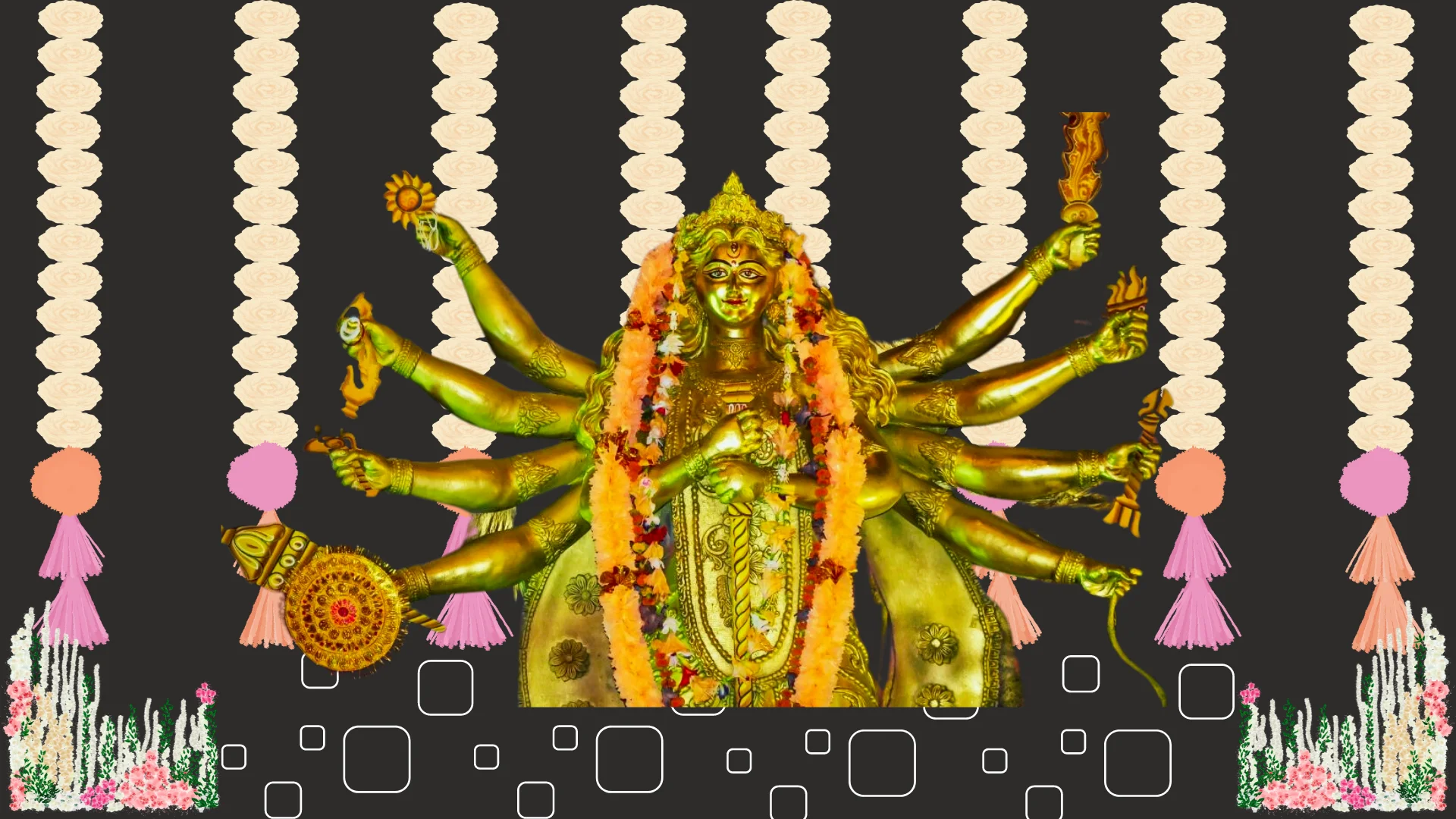What does Argala Mean?
Argala literally means obstacles or stoppages, which means that the Argala Stotram is a hymn that will remove obstacles from our life. The Argala Stotram not only focuses on praising Devi Durga but also gives us hints towards leading a happy and prosperous life. There is a little confusion about the number of verses of the Stotram.

At some places we see that this Stotram has 23 verses and in certain other places we see that the Stotram has 26 verses. This is because our Scriptures are ancient and we may have lost certain verses during translation or oral communication, with passage of time.
That is why one may see a lack of consistency not only in this Stotram but many such Stotrams that have been composed during ancient times. Goddess Chandika is the Adhishthatri Devi or that form of Durga Devi who finds first mention at the start of the Stotram.
Dual Role of Devi Durga
Goddess Durga plays a dual role in one’s life. She represents Victory and Auspiciousness for Her devotees. She assumes the form of Kali to end doom and darkness in the life of the chanter of this Stotram. She is praised as the better half of Lord Shiva and even feeds the Lord.
Her form as Annapurna Devi in Kashi is a reminder of the fact that anyone who praises Devi Durga will never go without food and drink. She is the mother of the universe and so, the regular reciter of the Stotram will never go unfed. Devi’s form as Swaha and Swadha finds mention in the verses.

As Swaha she is fiery and as Swadha she represents Laxmi Devi, an essential aspect of Prakriti, with beautiful teeth. Thus a person who respects women as Devi Durga, as Swadha, is always protected by the mother. Nature always cares for such a person who respects girls and women as one’s own mother and sister.
This is the special mercy of Devi Durga.
Those who are seeking to understand the true benefits of Argala Stotram will find that its impact goes far beyond material gains. It purifies not just the environment around the sadhak, but more importantly, the internal chatter of the mind. This cleansing of thoughts creates a sacred space within, where divine intuition can begin to speak. As this connection strengthens, one notices greater alignment with dharma, improved decision-making, and a life that naturally gravitates towards spiritual truth and righteous action.
Chant the Argala Stotram before the Durga Saptashati
Many times the Argala Stotram is read before the chanting of the Durga Saptashati. Chanting the Argala Stotram regularly can make you victorious in all your engagements.
The benefits of chanting Argala Stotram are deeply transformative. It does not merely grant success in worldly matters, but also gradually awakens the higher self. Each verse of the Stotram is like a spark that illuminates a dark corner of the subconscious mind. With consistent practice, one begins to shed toxic emotional patterns, gain mental resilience, and live from a space of shakti-filled inner confidence.
Argala Stotram Meaning in English
Invocation & Rishi Nyāsa
oṁ asya śrī argalā stotra mantrasya viṣṇu ṛṣiḥ | anuṣṭup chandaḥ |
śrī mahālakṣmīr devatā | śrī jagadambā prītyarthe saptaśatī pāṭhāṅgatvena jape viniyogaḥ |
oṁ namaś caṇḍikāyai ||
Meaning:
This hymn is called the Argalā Stotram. The seer (ṛṣi) is Lord Viṣṇu, the meter is Anuṣṭup, the deity is Śrī Mahālakṣmī, and it is to be recited to please Śrī Jagadambā, as a part of the Devī Mahātmyam (Saptaśatī).
Salutations to Caṇḍikā Devi!
॥ Śrī Argalā Stotram ॥
Verse 1
oṁ jayantī maṅgalā kālī bhadrakālī kapālinī |
durgā kṣamā śivā dhātrī svāhā svadhā namo’stu te ||1||
Meaning:
Salutations to You, O Goddess! You are Jayantī (Victorious), Maṅgalā (Auspicious), Kālī (Dark one), Bhadrakālī (Fierce yet kind form of Kālī), Kapālinī (Skull bearer), Durgā (Invincible), Kṣamā (Forgiveness), Śivā (Auspicious), Dhātrī (Supporter of all), Svāhā (oblations to deities), and Svadhā (oblations to ancestors).
Verse 2
jaya tvaṁ devi cāmuṇḍe jaya bhūtārti hāriṇi |
jaya sarvagate devi kālarātri namo’stu te ||2||
Meaning:
Victory to You, O Caṇḍikā Devi! You remove the sufferings of all beings. O Kālarātri, who pervades everything, we bow to You in reverence.
Verse 3
madhukaiṭabha vidrāvi dhātvavare namaḥ |
rūpaṁ dehi jayaṁ dehi yaśo dehi dviṣo jahi ||3||
Meaning:
Salutations to the one who destroyed Madhu and Kaiṭabha, and who bestows boons! Grant me beauty, victory, fame, and destroy my enemies.
Verse 4
mahiṣāsura nirnāśi bhaktānāṁ sukhade namaḥ |
rūpaṁ dehi jayaṁ dehi yaśo dehi dviṣo jahi ||4||
Meaning:
Salutations to the one who destroyed Mahiṣāsura and brings happiness to Her devotees! Grant me beauty, victory, fame, and destroy my enemies.
Verse 5
raktabīja vadhe devi caṇḍamuṇḍa vināśinī |
rūpaṁ dehi jayaṁ dehi yaśo dehi dviṣo jahi ||5||
Meaning:
O Devi, who slayed Raktabīja and annihilated Caṇḍa and Muṇḍa—grant me beauty, victory, fame, and destroy my enemies.
Verse 6
śumbhasyaiva niśumbhasya dhūmrākṣasya ca mardini |
rūpaṁ dehi jayaṁ dehi yaśo dehi dviṣo jahi ||6||
Meaning:
O destroyer of Śumbha, Niśumbha, and Dhūmrākṣa, grant me beauty, victory, fame, and destroy my enemies.
Verse 7
vanditāṅghriyuge devi sarvasaubhāgyadāyini |
rūpaṁ dehi jayaṁ dehi yaśo dehi dviṣo jahi ||7||
Meaning:
O Devi, whose feet are adored and who grants all forms of fortune—grant me beauty, victory, fame, and destroy my enemies.
Verse 8
acintya rūpacarite sarvaśatru vināśinī |
rūpaṁ dehi jayaṁ dehi yaśo dehi dviṣo jahi ||8||
Meaning:
O You of incomprehensible form and deeds, who destroys all enemies—grant me beauty, victory, fame, and destroy my enemies.
Verse 9
natebhyaḥ sarvadā bhaktyā caṇḍike duritāpaha |
rūpaṁ dehi jayaṁ dehi yaśo dehi dviṣo jahi ||9||
Meaning:
O Caṇḍikā, worshipped always by the devoted and remover of all suffering—grant me beauty, victory, fame, and destroy my enemies.
Verse 10
stuvadbhyo bhaktipūrvaṁ tvāṁ caṇḍike vyādhināśinī |
rūpaṁ dehi jayaṁ dehi yaśo dehi dviṣo jahi ||10||
Meaning:
O Caṇḍikā, destroyer of diseases, praised by Your devotees with devotion—grant me beauty, victory, fame, and destroy my enemies.
Verse 11
caṇḍike satataṁ ye tvām arcayanti bhaktitaḥ |
rūpaṁ dehi jayaṁ dehi yaśo dehi dviṣo jahi ||11||
Meaning:
O Caṇḍikā, those who constantly worship You with devotion—bless them with beauty, victory, fame, and the destruction of their enemies.
Verse 12
dehi saubhāgyam ārogyaṁ dehi me paramaṁ sukham |
rūpaṁ dehi jayaṁ dehi yaśo dehi dviṣo jahi ||12||
Meaning:
Grant me good fortune, health, and supreme happiness. Also bless me with beauty, victory, fame, and the destruction of my enemies.
Verse 13
videhi dṛṣṭiṁ nāśaṁ videhi balam uccakaiḥ |
rūpaṁ dehi jayaṁ dehi yaśo dehi dviṣo jahi ||13||
Meaning:
Grant me Your vision, destroy obstacles, and give me great strength. Bless me with beauty, victory, fame, and destroy my enemies.
Verse 14
videhi devi kalyāṇaṁ videhi paramaṁ śriyam |
rūpaṁ dehi jayaṁ dehi yaśo dehi dviṣo jahi ||14||
Meaning:
Grant me auspiciousness, O Devi, and the highest prosperity. Grant me beauty, victory, fame, and destroy my enemies.
Verse 15
surāsura śiro ratna nighṛṣṭa caraṇe ‘mbike |
rūpaṁ dehi jayaṁ dehi yaśo dehi dviṣo jahi ||15||
Meaning:
O Mother, whose feet are rubbed by the crown jewels of gods and demons—grant me beauty, victory, fame, and destroy my enemies.
Verse 16
vidyāvantaṁ yaśasvantaṁ lakṣmīvantaṁ janaṁ kuru |
rūpaṁ dehi jayaṁ dehi yaśo dehi dviṣo jahi ||16||
Meaning:
Make me wise, renowned, and abundant in wealth. Grant me beauty, victory, fame, and destroy my enemies.
Verse 17
pracaṇḍa daitya darpaghne caṇḍike praṇatāy me |
rūpaṁ dehi jayaṁ dehi yaśo dehi dviṣo jahi ||17||
Meaning:
O Caṇḍikā, destroyer of the arrogance of fierce demons—I bow to You. Please grant me beauty, victory, fame, and destroy my enemies.
Verse 18
caturbhuje caturvaktra saṁstute parameśvari |
rūpaṁ dehi jayaṁ dehi yaśo dehi dviṣo jahi ||18||
Meaning:
O Supreme Goddess praised in the form of four arms and four faces—grant me beauty, victory, fame, and destroy my enemies.
Verse 19
kṛṣṇena saṁstute devi śāśvat bhaktyā sadāmbike |
rūpaṁ dehi jayaṁ dehi yaśo dehi dviṣo jahi ||19||
Meaning:
O Eternal Mother, praised by Lord Kṛṣṇa with constant devotion—grant me beauty, victory, fame, and destroy my enemies.
Verse 20
himācala sutānātha saṁstute parameśvari |
rūpaṁ dehi jayaṁ dehi yaśo dehi dviṣo jahi ||20||
Meaning:
O Supreme Goddess, praised by Lord Śiva, consort of the daughter of the Himalayas—grant me beauty, victory, fame, and destroy my enemies.
Verse 21
indrāṇīpati sadbhāva pūjite parameśvari |
rūpaṁ dehi jayaṁ dehi yaśo dehi dviṣo jahi ||21||
Meaning:
O Supreme Goddess, worshipped with devotion by Indra, the husband of Indrāṇī—grant me beauty, victory, fame, and destroy my enemies.
Verse 22
devi pracaṇḍa dordaṇḍa daitya darpa vināśinī |
rūpaṁ dehi jayaṁ dehi yaśo dehi dviṣo jahi ||22||
Meaning:
O Goddess, with mighty arms who crushes the pride of demons—grant me beauty, victory, fame, and destroy my enemies.
Verse 23
devi bhaktajano ddāma dattānando daye’mbike |
rūpaṁ dehi jayaṁ dehi yaśo dehi dviṣo jahi ||23||
Meaning:
O compassionate Mother, who gives immense bliss to Her devotees—grant me beauty, victory, fame, and destroy my enemies.
Verse 24
patnīṁ manoramaṁ dehi manovṛttānusāriṇīm |
tāriṇīṁ durgasāṁsāra sāgarasya kulodbhavām ||24||
Meaning:
Grant me a wife who is beautiful, who follows my heart’s inclinations, who uplifts me from this ocean of worldly existence, and who is of noble lineage.
Verse 25
idaṁ stotraṁ paṭhitvā tu mahāstotraṁ paṭhen naraḥ |
sa tu saptaśatī saṅkhyā varam āpnoti saṁpadām ||25||
॥ iti śrī devyāḥ argalā stotraṁ sampūrṇam ॥
Meaning:
By reciting this Argalā Stotram and following it with the Devī Mahātmyam (700 verses), one attains the greatest wealth, prosperity, and blessings.
Benefits of Chanting the Argala Stotram
It also has the ability to remove bad thoughts from the mind. Continued chanting of Argala Stotram also has the ability to turn your attention towards spirituality and raises the level of thoughts, making you spiritual over a period of time. The shlokas of the Argala Stotram puts an end to the dark nights of our lives be it grief or sorrow. It has the ability to diffuse Agami and Sanchita Karma and reduces the intensity of Prarabdha Karma to a very great extent.

It helps us fight our internal enemies such as lust, anger, greed, envy, illusion and self-pride. It makes us more aware and conscious of our moral standards.
It keeps us away from diseases and repels people who have the tendency to back-bite.Understanding the Argala Stotram benefits in English allows global seekers to tap into its power with clarity. This sacred chant is not bound by language, but knowing its meaning enriches the recitation. In English, one sees how each verse is a direct appeal to the Divine Mother to bestow courage, destroy injustice, bless with wealth, and grant unwavering inner peace. This makes it especially potent for those on the path of both bhakti and self-healing.
An interesting combination of Stotrams is reading Durga Apaduddharaka Stotram along with the Argala Stotram for faster benefits.
The Durga Apaddhāraka Stotram is a sacred Sanskrit hymn dedicated to Maa Durga, revered especially during times of distress, crisis, or unforeseen obstacles. The term Apaddhāraka means “one who removes calamities,” and this stotra is believed to invoke the Devi’s fierce protective energy to shield the devotee from accidents, illness, legal issues, and psychic disturbances.
Among the many Durga Apaduddharaka Stotram benefits, one of the most profound is the immediate sense of divine security it bestows. Regular chanting of this stotram creates a spiritual armor, especially helpful during travel, during Rahu-Ketu periods, or when facing hostile environments. Devotees often report inner courage, clarity during chaos, and miraculous escapes from danger — all of which reflect the compassionate grace of the Divine Mother responding to sincere prayer. It is particularly potent when recited on Tuesdays, Fridays, or during Navratri.
The Argala Stotram hammers the chanter sometimes so that he is rid of his false ego and becomes humble. Some may see this as a misfortune. But such misfortunes transpire for our own higher good by which humility is enhanced. One of the best ways to augment the Argala Stotram is to combine it with the Navarna Yantra.
The Navarna Yantra: Devi Durga’s Living Shakti in Geometric Form
Mantra-Maya Vigraha: What Is the Navarna Yantra?
The Navarna Yantra is the sacred and living geometry of Devi Chandika, the fierce and compassionate aspect of Maa Durga. It is directly linked to the Navarna Mantra—”Om Aim Hreem Kleem Chamundayai Vichche”, a powerful bija mantra that encapsulates the essence of Devi’s energy. This mantra is considered the heart of the Durga Saptashati, and the yantra becomes its visual and energetic form.
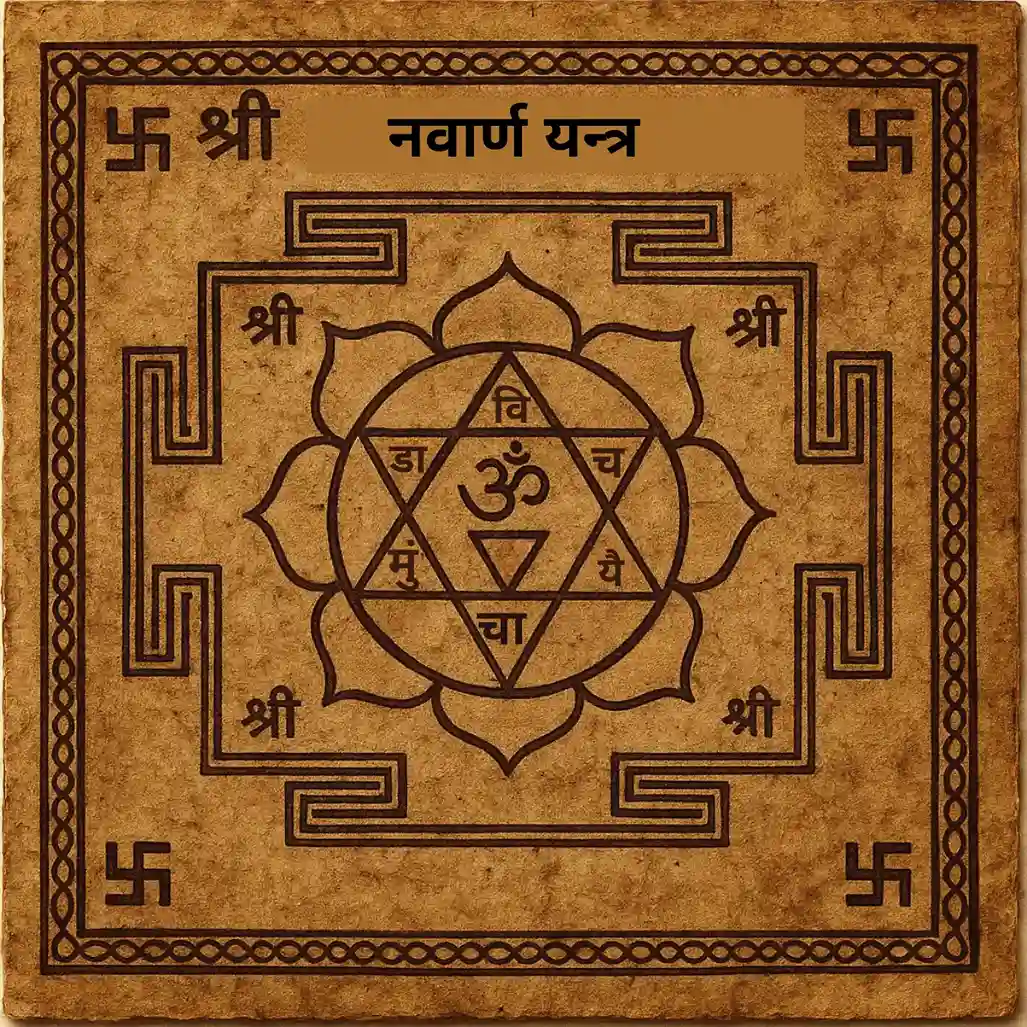
This yantra is not merely symbolic art but a living mandala that reflects the shakti of the mantra. It is often accompanied by other mantras like “Om Dum Durgayei Namaha,” “Om Chamundayai Namaha,” and “Om Hreem Shreem Kleem Durga Devyai Namaha.” Each of these mantras unlocks a facet of the Devi’s energy, whether it’s protection, abundance, purification, or fierce grace.
When one meditates upon the Navarna Yantra with bhakti, it begins to activate the dormant spiritual energies within. It is a portal or gateway, a subtle instrument through which the mantra enters the heart of the sadhaka and begins to work quietly, deeply, and irrevocably. With regular practice, the yantra becomes a living presence in the life of the devotee, guiding, guarding, and transforming.
Phala Shruti: Blessings of the Navarna Yantra
The blessings of the Navarna Yantra are profound and multidimensional. At the adhyatmic (spiritual) level, it acts as a purifier of past karmas—both agami (future-inclined actions) and sanchita (accumulated actions). For a sincere sadhak, the yantra becomes a companion in clearing the path towards moksha, helping in the inner dissolution of ego, attachment, and fear.
In the adhibhautika (physical and emotional) plane, the Navarna Yantra becomes a protective field. It shields the home and the aura of the devotee from subtle intrusions, be it drishti (evil eye), graha dosha (planetary affliction), or manasika ashanti (mental restlessness). The vibrations of the yantra create a sattvic space wherever it is kept. Families that worship this yantra regularly notice increased harmony, improved health, and resolution of long-standing tensions.

At the adhidaivika (cosmic and divine) level, it attracts the grace of the Devi. The yantra invokes not just one aspect of Durga but the complete navashakti—nine forms of the Goddess. With time, it brings intuitive guidance, clarity in decisions, protection from unseen dangers, and the silent but unmistakable presence of the Divine Mother in everyday life.
The Navarna Yantra is not about wish fulfillment in the ordinary sense. Rather, it transforms the very nature of one’s wishes, aligning them with dharma, seva, and spiritual evolution. Its blessings unfold subtly, gradually, and surely—like Devi’s touch upon the soul.
Yantra Rachana: Inner Structure of the Navarna Yantra
The architecture of the Navarna Yantra is deeply mystical and precise. At the very center is the bindu, the infinitesimal point of stillness from which all of Devi’s shakti emerges. This bindu is the seat of Chamunda herself—the Adi Shakti—residing in perfect balance and radiance.
Surrounding this bindu are interlacing triangles—upward-pointing for Shiva and downward-pointing for Shakti, forming a hexagonal star. This central star represents the union of masculine and feminine principles, the merging of consciousness and energy. It is the foundation for inner and outer harmony.
Encircling this core geometry is the eight-petaled lotus, known as the Ashtadala. Each petal represents one form of Durga’s energy—Shanti (peace), Lakshmi (abundance), Vidya (wisdom), Shakti (power), Daya (compassion), Raksha (protection), Arogya (health), and Siddhi (perfection). Outside the lotus lies the bhupura, the earthly enclosure representing the realm of human existence. This boundary grounds the yantra into physical reality, making it effective as a tool for healing and transformation.
Every layer of this yantra has a vibrational role in awakening the subtle body. It’s not just an object to be kept on a shelf—it’s an energetic map for awakening Devi within the sadhak. You may read our article on Krishna Yantra to immerse yourself in the melody of devotion and divine wisdom.
Shilpa Rahasya: Geometry and Energy Transmission
The geometry of the Navarna Yantra is not decorative, it is functional. Each angle and intersecting line serves a distinct role in energetic transmission. The upward triangles activate the solar nadi (pingala), bringing strength, focus, and willpower. The downward triangles activate the lunar nadi (ida), evoking surrender, bhakti, and nourishment.
The interlocked star at the center becomes a yantric vortex, drawing divine energy downward from the Sahasrara and distributing it to the chakras. The lotus petals generate pranic resonance in the heart chakra (Anahata), and the bhupura filters external distractions and protects the sanctity of the inner space.
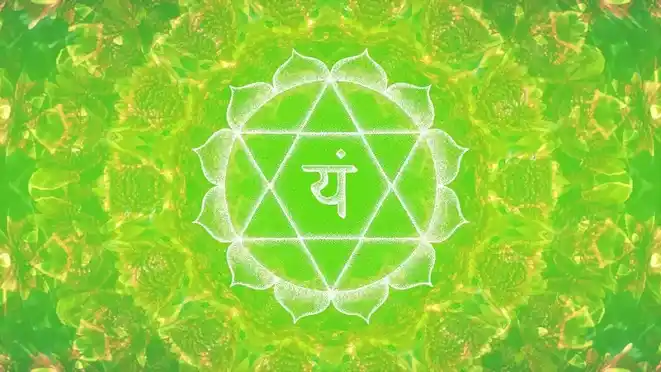
When meditated upon or used in japa sadhana, the yantra’s geometry fine-tunes the aura, corrects distortions in the subtle body, and raises one’s vibrational field. Over time, it harmonizes the koshas and supports deep stillness in the antahkarana (inner instrument of mind, intellect, ego, and memory).
This is the hidden engineering of Shakti, sacred geometry that awakens the divine blueprint inside the sadhak.
Mantra-Deeksha: Activating the Navarna Yantra
The activation of the Navarna Yantra requires mantra, intention, and the blessings of a living Guru. The primary bija that energizes this yantra is “Om Aim Hreem Kleem Chamundayai Vichche.” Other supporting beeja mantras include:
“Om Dum Durgayei Namaha,” “Om Chamundayai Namaha,” “Om Hreem Shreem Kleem Durga Devyai Namaha,” and “Om Aing Hreeng Kleeng.”
These mantras must be chanted with devotion and awareness while meditating on the yantra. The recitation creates a vibrational resonance that makes the yantra dynamic and spiritually responsive. The Gayatri aligned with Durga Devi that is often used is:
“Om Katyayanyai Vidmahe Kanyakumari Dhimahi Tanno Durga Prachodayat.” While anyone may reverentially keep the yantra, for deeper sadhana and real transformation, Guru Deeksha is an important ingredient. Without the Guru’s transmission of mantra shakti, the yantra remains geometrical potential. With Deeksha, the Yantra becomes Chaitanya infused, conscious and benevolent.
Yantra-Siddhi: How the Yantra is Prepared at YantraChants.com
At YantraChants.com, the Navarna Yantra is never printed. It is hand-drawn on authentic Himalayan Bhojapatra, prepared according to the timeless prescriptions of our Guru-Paramparā, not merely as an art but as an act of tapas.
Each line of the yantra is inscribed using sacred red pastes, kumkum, ashtagandha, saffron, and the extract of divine rose, prepared freshly with sanctified water. These materials are chosen not for aesthetic, but for their subtle vibrational potency to hold mantra-shakti.
Vedic Rituals: The Living Tradition Behind Each Yantra
The process begins only during Shakti-aligned muhurta timings, such as Navratri Ashtami, Chaitra Navami, or during Brahma Muhurta, when the prana of the cosmos is most receptive. Before the yantra is even touched, the sadhaka performing the kriya undertakes strict achara, including ritual bathing, fasting, and inward mantra japa to prepare their own field.
The Navarna Mantra is chanted 108 or 1008 times during the drawing, with every akshara resonating into the geometry of the yantra. The syllables are infused into the very structure, making it a living field of Devi Shakti. Nyasa (placing of mantras in different body parts), and Mudra Kriyas are used to breathe subtle life into the yantra.
Guru-Paramparā Shakti: The Real Transmission
The final and most vital act is the Guru-Transmission. The yantra is taken before a Self-Realized Master in our lineage, who performs a silent transfer of shakti through drishti (gaze), sankalpa (will), or sparsha (touch), depending on the suitability of the recipient. This is not symbolic. It is an actual energetic embedding of the Guru’s awakened current into the yantra. In many cases, it is this infusion, more than the mantra or the geometry, that causes seekers to report visions sometimes, spontaneous tears, or inner shifts, even before beginning formal sadhana.
The yantra is treated not as a product, but as a Devi-Vigraha, a conscious embodiment of the Goddess Herself. It does not merely sit at your altar, it walks with you, watches you, responds to your sincerity, and guides you as a hidden spiritual companion.
Guru-Tattva: Importance of a Self-Realized Guru
A yantra, however sacred, remains a dormant diagram unless awakened by Guru-Tattva. It is only a Self-Realized Guru, one who has realized the Devi within and crossed the ocean of ego, who can breathe life into a yantra. The Guru doesn’t merely bless the yantra; the Guru invokes Devi’s shakti into it through prāṇa-pratishṭhā.
This activation isn’t just external. The Guru aligns the energy of the yantra to the soul of the sadhak. A disciple who receives the yantra through Guru Parampara feels an immediate spiritual resonance, because it is not a material object anymore, but a conscious companion on the journey to moksha. In truth, the Guru, the yantra, and the mantra are not three separate elements but one seamless river of Divine flow.
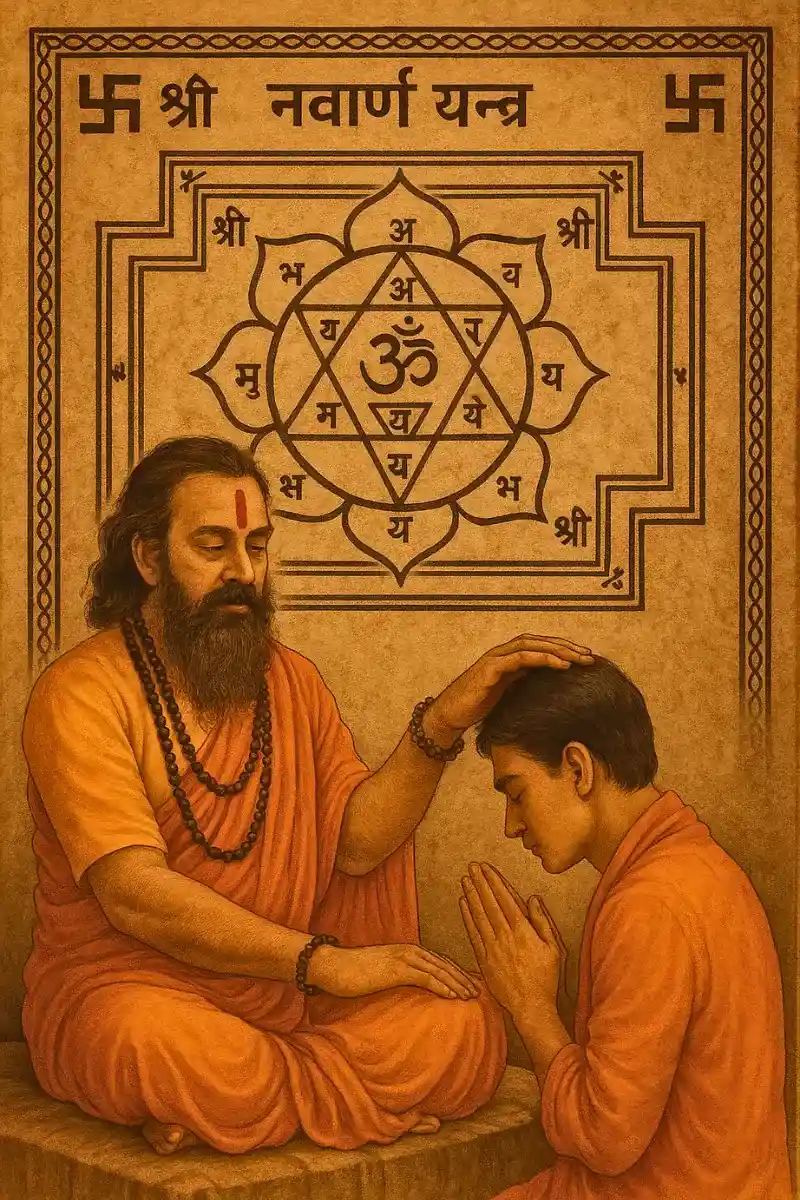
Those who try to use yantras without Guru guidance often find themselves confused, distracted, or spiritually stagnant. But with a Guru’s touch, the yantra becomes alive, responsive to the sadhak’s devotion, karma, and readiness. This is not superstition, it is Shastra-anusāra (aligned with scripture) and Anubhava-siddha (verified through experience).
Chamatkara: Rare Observations with the Yantra
Many sadhakas who sincerely worship the Navarna Yantra have reported subtle and sometimes dramatic signs of inner transformation, and transformation or infusion of sudden positive events, sometimes even unimaginable. Some physical symptoms are feeling heat or tingling in the hands while holding the yantra. Others experience a pull to meditate more often, or receive vivid dreams in which Devi appears with symbolic messages.
During festivals like Navratri or during Poornima, the Full Moon days, the yantra responds with heightened shakti. When placed on an altar and worshipped during Ashtami or Amavasya nights, its energy field expands, purifying the home. Some practitioners observe synchronicities, answers appearing before questions are asked, or blockages suddenly dissolving. These are not coincidences, they are chamatkāras, grace-filled glimpses of the Devi’s lila.
Even those who keep the yantra silently, without elaborate ritual, often find themselves gradually leaning toward sattvic food, spiritual company, and dharmic work. This is how Devi works, not loudly, but surely, and with supreme compassion.
Tantra-Agama: The Yantra as Astral Shastra
In the tantric tradition, the Navarna Yantra is considered an astral weapon, a divine yantra-shastra forged from mantra and consciousness. It cuts through karmic knots and psychic disturbances the way a sword cuts through illusion. When placed on the altar, it acts like a guardian, shielding the space and redirecting hostile energies.
The seer Rishi Markandeya, who gave us the Argala Stotram and the Durga Saptashati, was not merely a poet. He was a realized rishi who encoded mantra-yantra-tantra in scriptural form. The yantra you see today is a continuation of his lineage. Each triangle, petal, and line is a siddha language that only silence and tapas can decipher.
As an astral force, the Navarna Yantra doesn’t just protect, it transforms. It turns the seeker’s karmic battlefield into a temple, and the struggle into surrender. It is Durga’s grace made visible.
Increasing to Higher Limits
Sometimes we set our own limits out of fear and avoid confronting situations.
These limitations and boundaries get dissolved through regular chanting of the Argala Stotram. Our negative thoughts have the ability to breed viruses and harmful bacteria within our own body.
When seekers explore the benefits of Argala Stotram in English, they come to realize that its core gift is empowerment. The Stotram does not ask us to surrender to fear, but rather invites us to walk boldly with the grace of Durga Devi by our side. Each verse works as a subtle weapon that weakens the grip of past traumas, karmic residues, and psychological barriers that keep one from their fullest potential.
The Stotram arrests the multiplication of such organisms within the body, by first eliminating our negativity and then relieving us of the diseases caused by such organisms.
This is not to say that the mantra does this work without external intervention.
What the Stotram does is that it introduces the best doctors and medication to us, keeping the expenditure low. The Stotram is particularly effective in curing blood related illnesses.
Many practitioners have experienced tangible shifts when chanting the Argala Stotram for health. It is believed that the vibrational pattern of these mantras resonates with the vital organs and nervous system. When chanted regularly, it strengthens the subtle energy fields, increases immunity, and even improves the body’s ability to heal itself naturally. Especially when combined with energized yantras and sattvic diet, the effects can be life-altering.
Protection from Shame and Criticism
Naturally chanting this Stotram for about 6 months will help us discover great inner calm and peace. The chanting of the Argala Stotram will also shield us from blame, dishonor, shame, criticism and clever people who are out there to topple us. By regularly chanting this Stotram one will attain qualities of pure clean speech and leadership qualities.

For those new to this path, exploring the Argala Stotram meaning in English provides a doorway into the deeper spiritual psychology embedded in every line. The Stotram is not simply a request for outer success, it is a coded map for inner purification. Understanding each verse’s meaning reveals the subtle science of invoking Devi Durga’s many shaktis to transform weakness into strength, doubt into clarity, and fear into faith.
Goddess Durga also grants victory, fame, and money. When one learns to meditate deeply on the Stotram, it gives the chanter special benefits. It destroys the poison that life brings with it, during every lifetime. When this poison is destroyed, liberation is available to the chanter. Such is the potency of the Argala Stotram.
The Stotram also helps activating the Ajna and Crown Chakra. Thus the Stotram is an important tool towards awakening the Kundalini Shakti.
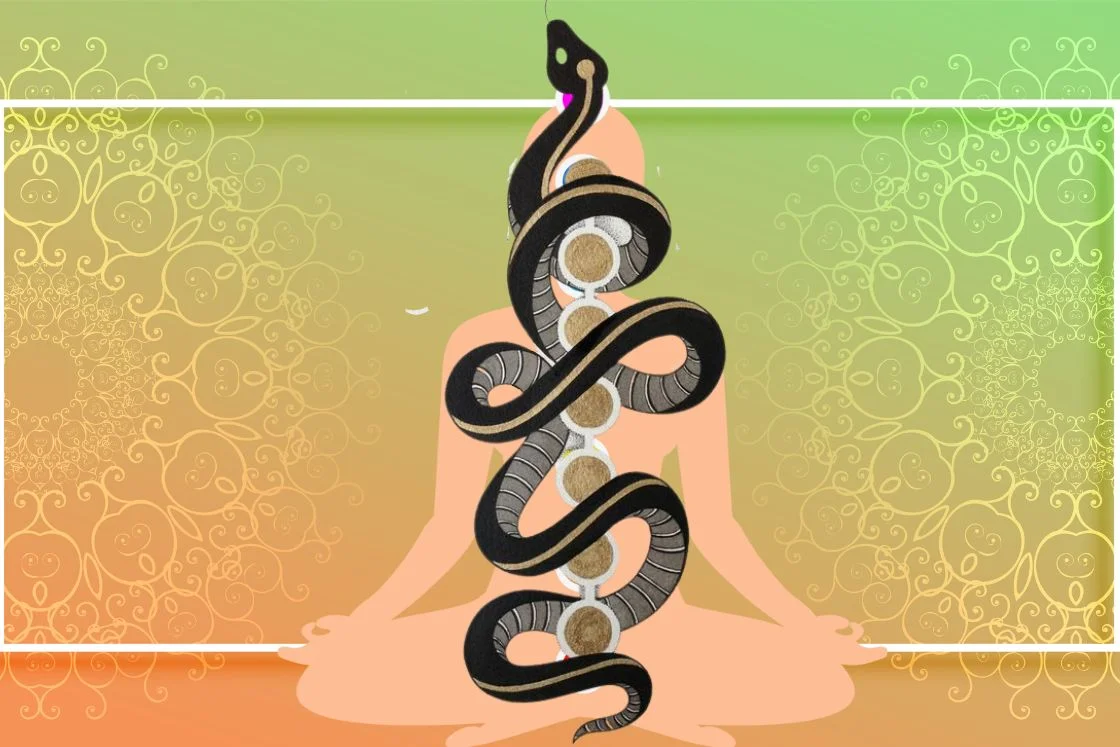
For some people reciting the Stotram have seen their creativity levels go up.
Prolonged chanting of the Argala Stotram can take you to a state of thoughtlessness. Thus the Argala Stotram is like a Kalpa Vriksha or a wish fulfilling tree.
One should chant the Stotram under the guidance of a Guru for maximum results. Yet this Stotram does not mandate an initiation process.
Connect to the universal feminine force. Request this yantra to harmonize your home, aura, and spiritual flow.

